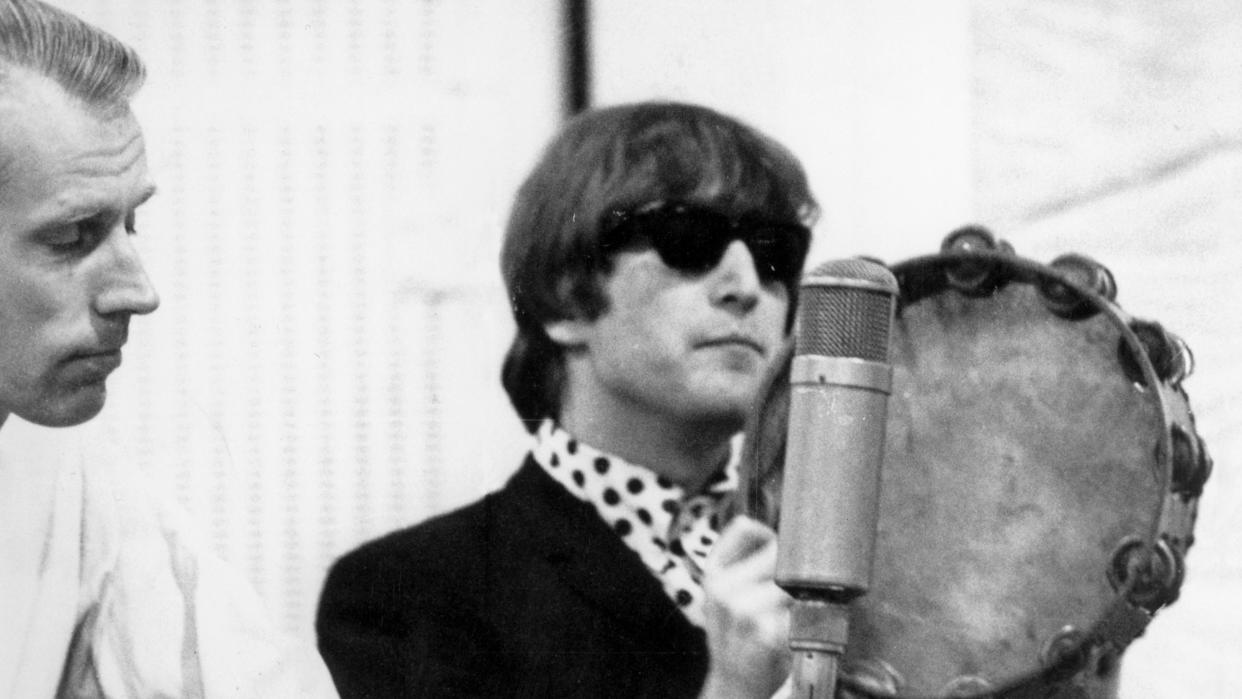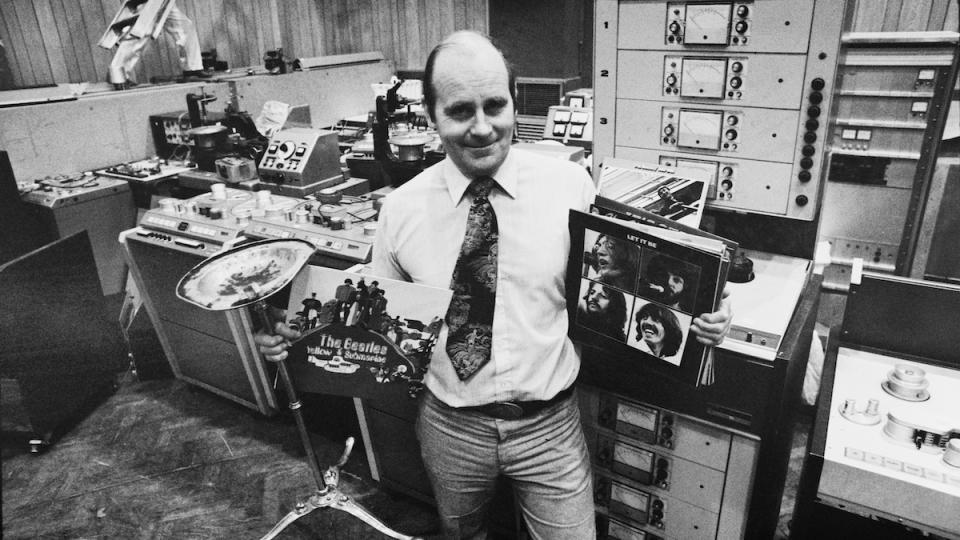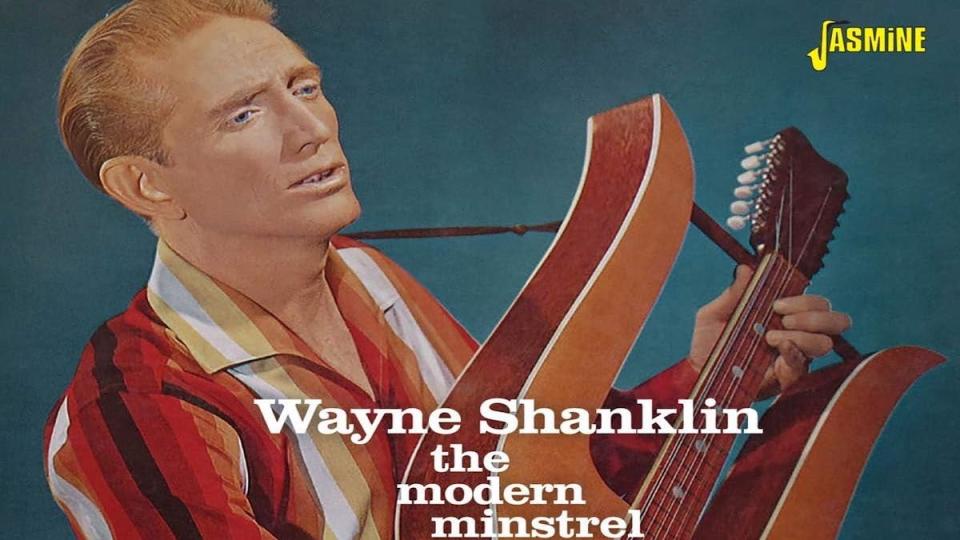"I said, 'we've added a double wiflocated sploshing flange.' John laughed and said 'let's flange again then'": George Martin and John Lennon thought they'd invented flanging but the whole debate has now taken an odd turn

- Oops!Something went wrong.Please try again later.
- Oops!Something went wrong.Please try again later.
- Oops!Something went wrong.Please try again later.
The discovery of flanging – that being the tape-phasing, jet plane, comb-filter effect – was widely attributed to The Beatles and George Martin. We say 'was' because we questioned the very history of the effect in this feature and think others should be given some credit. However a recently unearthed George Martin interview reveals a slightly odd version of these flanging events.
George Martin, of course, helped the Beatles make some of the most famous recordings ever committed to tape at Abbey Road studios. Together with engineers like Geoff Emerick, they famously explored all sorts of techniques including tape loops, backwards recording and multitrack recording.
Ken Townsend inadvertently introduced a flanging effect on Lennon's voice
It was during the recording of Revolver and the track Tomorrow Never Knows that the Fab Four's innovative studio techniques reached something of a peak.
Emerick introduced a new way of recording John Lennon's voice through a Leslie cabinet for the famous lo-fi sounding vocals in the song. Meanwhile, maintenance engineer Ken Townsend inadvertently introduced a flanging effect on Lennon's vocal. He recorded two identical vocals together, with one slightly delayed through a second tape machine.
This process is artificial double tracking or ADT and was used because Lennon hated recording his vocals twice. Hear the multiple vocal processes in full effect here.
The phasing and flanging effect of ADT was introduced if the speed of one of the tape machines was altered slightly. Lennon loved the effect so much he wanted to know how it worked.
George Martin didn't want to bother explaining the real science behind the effect to Lennon so said, "we take the original image and split it through a double vibrocated sploshing flange with double negative feedback." Lennon understood Martin's joke but would later ask for 'Ken's flanger' whenever he wanted the phasing effect on his voice.

The term 'flange' stuck and has become the widely used name of the famous effect. However, in our earlier feature we revealed that (at least) two other musicians had recorded the effect previous to The Beatles.
One was on a track called The Big Hurt by Miss Toni Fisher, which was written by Wayne Shanklin in 1959. It was produced at Gold Star Studios with engineers Larry Levine and Stan Ross helping to record it on a 2-track tape machine.
"Wayne comes in and says 'I want to try something and that is to double her voice and the way to do that is to make a copy of this tape and play both tapes simultaneously'."
They realised that the required vocal they'd recorded was too low in volume so used a similar voice doubling technique. Larry recalled of the recording: "Wayne comes in and says 'I want to try something and that is to double her voice and the way to do that is to make a copy of this tape and play both tapes simultaneously'".
While trying to make the doubled-up recording, the tape machines ran out of sync as their speeds varied. This resulted in the flanging effect which Wayne loved, so it was kept on the final recording.
However there was an earlier, more subtle example of flanging. Electric guitar pioneer Les Paul was also something of a recording wizard and would invent various effects and sound on sound multitrack recording techniques.
Paul apparently came up with the phasing effect in the 1940s and 50s when he mixed two acetates together on variable speed record players. Again this was mixing two identical audio parts together and the speed of one slightly varying.
You can hear the effects on the 1952 track Mammy's Boogie here.
As you can hear, it's pretty subtle and, forced into a conclusion and answering the question 'who invented flanging?' we opted to give the prize to Wayne as his use was more deliberate and more used as a dramatic recorded effect.

But while Wayne might have (accidentally) created the effect, the naming of it, we agreed, had to be down to George Martin and john Lennon. Martin came up with the joke word, and Lennon kept on using it.
However, a 1983 interview with George Martin in Home & Studio Recording puts an odd slant on the story. Martin still recounted the same story with Lennon as follows.
"So 'flange' was just another of our joke words," he said, "and when we first did ADT on John's voice and let him hear the result he thought it was absolutely marvellous, he came up and said 'fantastic, what you done, that's great and what do you call it?'. And I said to him, 'Oh, it's very simple, John, all we've done is taken the voice, split it in two, and added a double wiflocated sploshing flange'. Which was just a bit of gobbledegook. And he laughed and said after that 'well let's flange the voice again'."
(You might notice that in this version, Martin uses the word 'wiflocated' instead of 'vibrocated' but we're not splitting hairs.)

Martin then went on to reveal more…
"I was quite surprised some years later to be working in America and have someone talk to me about flanging," he said. "I said 'where do you get that from', and he said 'I don't know, it's a way of treating the voice electronically with tape'. I said 'yes I know that but where did you get the word from', and he said 'well they get it from putting their finger on the flange of the thing.'" The thing being the tape reel to slow it down and create the effect.
So what is strange is that Martin completely made up the name 'flange' as a joke, but that in the States the effect – possibly handed down from Wayne Shanklin or even Les Paul who both recorded in the country – was also called flanging.
In the interview, Martin doesn't explain the coincidence and sounds perplexed because it sounds like the two sets of studio engineers were using the same term for the same effect in different countries unaware of the other's usage. Or it could be that his use of the word had become so widespread that it had reached the States and engineers had assumed the flange was part of the tape reel or machine.
The latter option is the more likely, but either way, we're still going with Les Paul as the inventor, but Wayne as the first to popularise the effect. But as to who came up with the name, well that's just become a wiflocated and sploshing mystery.

